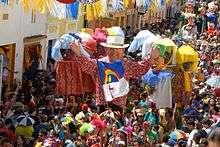Carnival block
Carnival blocks, carnaval blocos or blocos de rua are street bands that mobilize crowds on the streets and are the main popular expression of Brazilian Carnival. These parades fall under the term "street carnival", and happen during a period of about one month, beginning before and finishing after Carnival. Carnaval blocos usually perform samba music all around Brazil, but other popular musical styles (also identified with Carnaval) are present in specific regions, including frevo and maracatu in Pernambuco and axé in Bahia.
In Rio de Janeiro
Street carnival blocos have become a mainstay of Rio's Carnival, and today, there are several hundred blocos. Block parades start in January, and may last until the Sunday after Carnival. Carnaval Blocos are found throughout Rio de Janeiro. One of the largest and oldest blocos is the Cordão do Bola Preta, based in downtown Rio. Other large groups include Banda de Ipanema and Monobloco.
In Recife and Olinda

In Recife, the carnival block Galo da Madrugada was registered in the Guinness Book of World Records as the biggest carnival parade in the world. In its 2013 parade, the crowd following the bloco was larger than 2,500,000 people[1]).
Besides Galo da Madrugada, thousands of others carnival blocks with sizes ranging from few hundred to millions of people, perform in the streets of Recife and Olinda including As Virgens de Olinda, Eu Acho É Pouco, Batutas de São José, Lenhadores, Pitombeiras, Segura o Talo, Bloco da Saudade, Enquanto Isso Na Sala de Justiça and Homem da Meia-Noite.